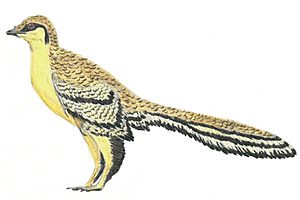Aurornis facts for kids
Quick facts for kids Aurornis |
|
|---|---|
 |
|
| Life restoration | |
| Scientific classification |
|
| Kingdom: | Animalia |
| Phylum: | Chordata |
| Clade: | Dinosauria |
| Clade: | Saurischia |
| Clade: | Theropoda |
| Family: | †Anchiornithidae |
| Genus: | †Aurornis Godefroit et al., 2013 |
| Type species | |
| †Aurornis xui Godefroit et al., 2013
|
|
Aurornis is a very old type of dinosaur that was closely related to birds. It lived a long, long time ago in what is now China. Scientists found its fossil in 2013. Some experts think Aurornis xui might be the most "primitive" or earliest bird species ever found. It could be even older than the famous Archaeopteryx, which many people thought was the first bird. Aurornis might have lived about 10 million years before Archaeopteryx!
What was Aurornis like?
Scientists described Aurornis from a fossil found in sedimentary rock in 2013. This fossil was bought from a local seller. The seller said it came from a place called Yaoluguo in western Liaoning, China.
At first, tests showed the fossil came from the Tiaojishan Formation. This rock layer is about 160 million years old. That means it's from the late Jurassic period. The fossil showed traces of soft, downy feathers. These feathers were along the animal's tail, chest, and neck. The fossil was not fully prepared when it was bought. This meant the feathers were not yet visible. There were also no signs that the fossil had been faked.
Aurornis was about the size of a modern pheasant. It was about 50 cm (20 in) long from its beak to the tip of its tail. It had claws on its feet and a long tail. Its leg bones were similar to those of Archaeopteryx. However, its overall bone structure was more basic or "primitive." It didn't have large feathers, which suggests Aurornis xui probably could not fly.
Doubts about its age
On June 7, 2013, the journal Science reported some doubts. Pascal Godefroit was the paleontologist who led the team that studied Aurornis. He became unsure if the fossil really came from the 160-million-year-old Tiaojishan Formation. This was what the fossil dealer had claimed.
It's possible the fossil came from the 125-million-year-old Yixian Formation instead. This area is known for many ancient bird fossils. Not knowing the exact origin or "provenance" of the fossil caused problems. It made people doubt if Aurornis was truly 160 million years old. This also questioned if it was older than Archaeopteryx. Godefroit's team planned to do more tests. They wanted to check the fossil's age using mineral and plant analysis on the shale rock.
How is Aurornis classified?
In 2013, scientists did a "phylogenetic analysis" of Aurornis. This is a way to study how living things are related. The analysis suggested that Aurornis belongs to the bird family tree. It was placed in a more "basal" or earlier position than Archaeopteryx. This study looked at almost 1,500 different body features.
However, calling Aurornis xui a "bird" is a bit tricky. This is because there are many different ways to define what a "bird" is. Paul Barrett, from the Natural History Museum in London, said that new discoveries show how blurry the line is between birds and non-bird dinosaurs. He explained that there's a smooth change in features between them. This makes it very hard to tell them apart.
Barrett added that Aurornis xui is definitely an older member of the bird family than Archaeopteryx. He said it's fair to call it a very primitive bird. But what you call a bird often depends on your definition. Many definitions are based on Archaeopteryx. Lawrence Witmer, an expert in bird evolution, found the new study convincing. But he agreed it's still hard to tell birds from bird-like dinosaurs. He said all these small feathered creatures were very similar.
American paleontologist Luis Chiappe had a different view. He said that Aurornis xui's front limbs were too short to be a true bird. He concluded that it "is very birdlike, but it is not yet a bird."
See also
 In Spanish: Aurornis xui para niños
In Spanish: Aurornis xui para niños

